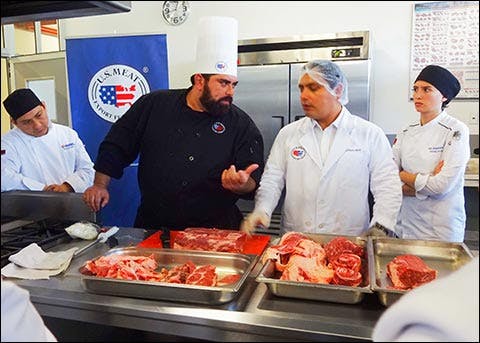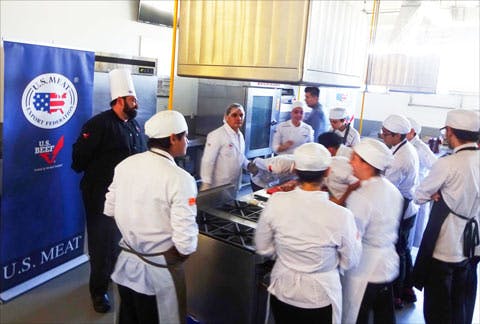Future Chefs Shown Advantages of U.S. Beef in Mexico
Teaching culinary students how to prepare cost-effective cuts was the goal of a U.S. beef cutting and cooking seminar conducted at the Culinary School of the University Mondragon in Queretaro, Mexico. The forward-looking seminar, funded by the Beef Checkoff Program, was designed to encourage future decision-makers to choose U.S beef when they begin working in Mexico’s restaurant, hotel and foodservice industries.

USMEF meat consultant Luis Pachuca and USMEF Chef Emilio Carranza demonstrate the preparation of U.S. beef during a seminar held at the Culinary School of the University Mondragon in Queretaro, Mexico
Well known for its culinary program that allows future chefs and restaurant managers to gain hands-on experience in kitchen operations, the University Mondragon is seen by USMEF as the ideal setting to promote the positive attributes of U.S beef.
“One key objective was to highlight the options available from the U.S. beef industry when it comes to high-quality cuts, especially those that are available at affordable prices,” explained Julieta Hernandez, USMEF HRI manager in Mexico. “We made students aware of beef cuts that are not currently popular in the Mexican market that could be of value to restaurants and hotels. For example, we showed students how to do the costing of a shoulder clod primal cut. This was done to compare the cost on an unconventional cut versus a commercial cut that is popular, such as a ribeye.”
A portion of the seminar was directed by USMEF meat consultant Luis Pachuca, who presented a cutting demonstration on U.S. beef primal shoulder clod. Pachuca explained the attributes and characteristics of U.S. beef and offered students looks at cuts such as the flatiron, heart clod, teres major (petite tender) and ranch steak. Students also had opportunities to participate in the cutting demonstration.
USMEF Chef Emilio Carranza offered recipe and cooking suggestions for some of the cuts presented, and prepared a chicharron using U.S. ribeye. Students were then given tasting samples of the cuts.
Students surveyed following the seminar indicated they picked up valuable information from the demonstrations and cutting exercises. USMEF is planning to organize similar seminars at other leading culinary schools.

Culinary students gather to learn more about alternative cuts of U.S. beef and the cost savings achieved by utilizing these cuts
“These types of activities that involve future chefs represent a great investment in the long term, as they promote U.S. red meat to a student base that will soon be making decisions about menus and recipes,” said Lorenzo Elizalde, USMEF trade manager in Mexico. “We plan to continue to pursue these opportunities in Mexico, because the country’s restaurant and foodservice industries are potentially big customers of U.S. beef, pork and lamb.”
